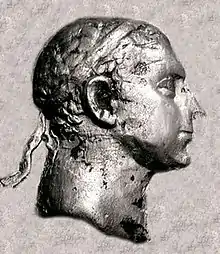Pantaleon
Pantaleon (Greek: Πανταλέων) was a Greek king who reigned some time between 190–180 BC in Bactria and India. He was a younger contemporary or successor of the Greco-Bactrian king Demetrius, and is sometimes believed to have been his brother and/or subking.
| Pantaleon | |
|---|---|
 Portrait of Pantaleon. | |
| Indo-Greek king | |
| Reign | 190–180 BC |
| Predecessor | Demetrius I |
| Successor | Agathocles |
| Died | 180 BCE |
| House | Euthydemid |
| Father | Euthydemus I |



Obv: Bust of Dionysos with a wreath of leaves.
Rev: Panther with a small bell around the neck, touching a vine with the left leg. Greek legend: ΒΑΣΙΛΕΩΣ ΠΑΝΤΑΛΕΟΝΤΟΣ "Of King Pantaleon".
The scarcity of his coinage indicates a short reign. Known evidence suggests that he was replaced by his (probable) brother or son Agathocles, by whom he was commemorated on a "pedigree" coin.
Copper-Nickel coinage
Some of his coins (as well as those of Agathocles and Euthydemus II) have another surprising characteristic: they are made of copper-nickel alloy, a technology that would not be developed in the West until the 18th century, but was known by the Chinese at the time. This suggests that exchanges of the metallic alloy or technicians happened between China and the region of Bactria.
Bilingual Indian-standard coinage
He was the first Greek king to strike Indian coins, peculiar irregular bronzes representing a lion with a dancing Indian woman, probably the goddess Lakshmi (a type also known in the Post-Mauryan coinage of Gandhara), which suggests he had his base in Arachosia and Gandhara and wanted support from the native population.

 Dancing woman, possibly Lakshmi, on a coin of Pantaleon.
Dancing woman, possibly Lakshmi, on a coin of Pantaleon.
External links
| Preceded by Demetrius I |
Indo-Greek Ruler (Arachosia, Gandhara) 190–185 BCE |
Succeeded by Apollodotus I |
- O. Bopearachchi, "Monnaies gréco-bactriennes et indo-grecques, Catalogue raisonné", Bibliothèque Nationale, Paris, 1991, p.453
- Quintanilla, Sonya Rhie (2 April 2019). "History of Early Stone Sculpture at Mathura: Ca. 150 BCE - 100 CE". BRILL – via Google Books.